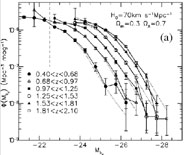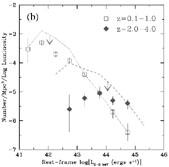


3.2. Recent X-ray Results on AGN Evolution
Optical studies of AGN evolution have typically focused on luminous
quasars. These have been known to evolve strongly with redshift since ~
1968, having a comoving space density at
z  2 that is
2 that is
 100
times higher than at
z
100
times higher than at
z  0.
Figure 6a shows optical luminosity
functions in 6 redshift "shells" spanning z = 0.40-2.10 for
~ 16,800 luminous AGN from the 2dF and 6dF surveys. Clear positive
evolution with redshift is observed, and pure luminosity evolution (PLE)
models provide an acceptable fit to these data.
New optical AGN surveys, such as COMBO-17, have recently discovered
significant numbers of moderate-luminosity AGN (with
MB > -23)
at z
0.
Figure 6a shows optical luminosity
functions in 6 redshift "shells" spanning z = 0.40-2.10 for
~ 16,800 luminous AGN from the 2dF and 6dF surveys. Clear positive
evolution with redshift is observed, and pure luminosity evolution (PLE)
models provide an acceptable fit to these data.
New optical AGN surveys, such as COMBO-17, have recently discovered
significant numbers of moderate-luminosity AGN (with
MB > -23)
at z  1-4,
allowing investigation of their evolution. As for
luminous quasars, the AGN found in these surveys also appear to peak in
comoving space density at z
1-4,
allowing investigation of their evolution. As for
luminous quasars, the AGN found in these surveys also appear to peak in
comoving space density at z
 2. Both PLE
and pure density evolution (PDE) models can acceptably fit the COMBO-17
data alone. Although a systematic combination of the COMBO-17 data with a
large sample of higher-luminosity AGN has yet to be published, there are
hints that the redshift at which the comoving space density peaks is
smaller at lower luminosities.
2. Both PLE
and pure density evolution (PDE) models can acceptably fit the COMBO-17
data alone. Although a systematic combination of the COMBO-17 data with a
large sample of higher-luminosity AGN has yet to be published, there are
hints that the redshift at which the comoving space density peaks is
smaller at lower luminosities.
 |
 |
Figure 6. (a) Optical luminosity functions in 6 redshift "shells" spanning z = 0.40-2.10 for ~ 16,800 luminous AGN from the 2dF and 6dF surveys. Note the clear positive evolution with increasing redshift at high luminosity (i.e., the comoving number density of luminous AGN increases with redshift from z = 0.40-2.10). From S.M. Croom, R.J. Smith, B.J. Boyle, et al., 2004, MNRAS, in press (astro-ph/0403040). (b) X-ray (2-8 keV) luminosity functions in two redshift "shells" (as labeled) for moderate-to-high luminosity AGN from the CDF-N, Abell 370, SSA13, and SSA22 Chandra surveys (see Table 1) as well as several earlier X-ray surveys. The dotted and dashed curves show the maximum possible luminosity functions after allowing for incompleteness of the follow-up spectroscopy. Note the apparent negative evolution with increasing redshift at moderate luminosity. Adapted from L.L. Cowie, G.P. Garmire, M.W. Bautz, et al., 2002, ApJ, 566, L5. |
|
As noted in Section 3.1, the deepest
X-ray surveys efficiently select AGN
even fainter than those found by COMBO-17 out to high redshift
(e.g., see Figure 5). X-ray AGN
samples show a clear dependence
of AGN evolution upon luminosity, with strong positive evolution only
being seen at high luminosities (see Figure 6b).
Lower luminosity AGN appear to be about as common at
z  0-1 as they ever
were, consistent with trend hinted at by COMBO-17. These results are robust
to incompleteness of the spectroscopic follow up, although clearly they
are still dependent upon the completeness of AGN X-ray selection
(see Section 3.1). It appears that while
the SMBH in rare, luminous AGN could grow efficiently at high redshift,
the SMBH in most AGN had to wait longer to grow.
0-1 as they ever
were, consistent with trend hinted at by COMBO-17. These results are robust
to incompleteness of the spectroscopic follow up, although clearly they
are still dependent upon the completeness of AGN X-ray selection
(see Section 3.1). It appears that while
the SMBH in rare, luminous AGN could grow efficiently at high redshift,
the SMBH in most AGN had to wait longer to grow.
Figure 7 shows estimates of the comoving spatial
density of AGN in
three X-ray luminosity ranges as a function of redshift. These have
been constructed utilizing a combination of Chandra, ASCA,
and HEAO1 surveys at photon energies above 2 keV (with 247 AGN in
total). The data are best fit with luminosity-dependent density evolution
(LDDE) out to some cutoff redshift (zc), where
zc increases
with luminosity; as a result, the ratio of the peak spatial density to
that at the present day is higher for more luminous AGN. At a basic
level, LDDE also seems more physically plausible than PLE or PDE; simple
PLE models tend to overpredict the number of
 1010
M
1010
M black holes in the local universe, while simple PDE models tend to
overpredict the local space density of quasars.
black holes in the local universe, while simple PDE models tend to
overpredict the local space density of quasars.
 |
Figure 7. The comoving spatial density of AGN in three X-ray luminosity ranges as a function of redshift, derived using data from several X-ray surveys. From Y. Ueda, M. Akiyama, K. Ohta, et al., 2003, ApJ, 598, 886. |